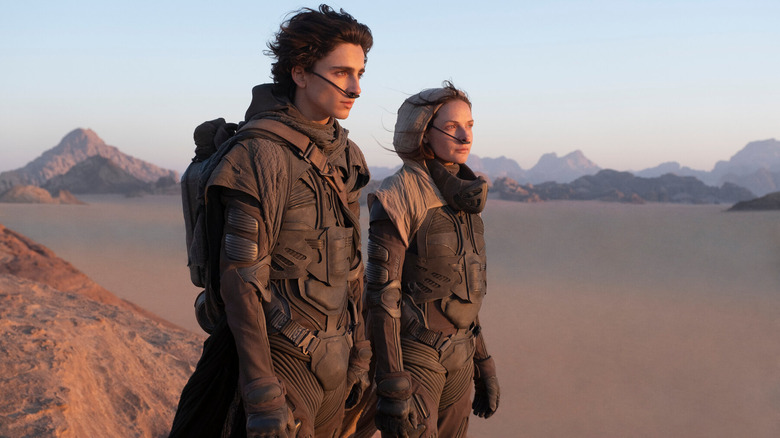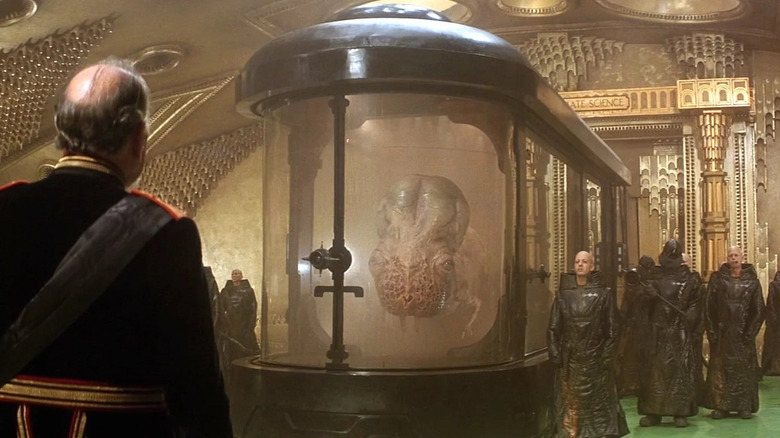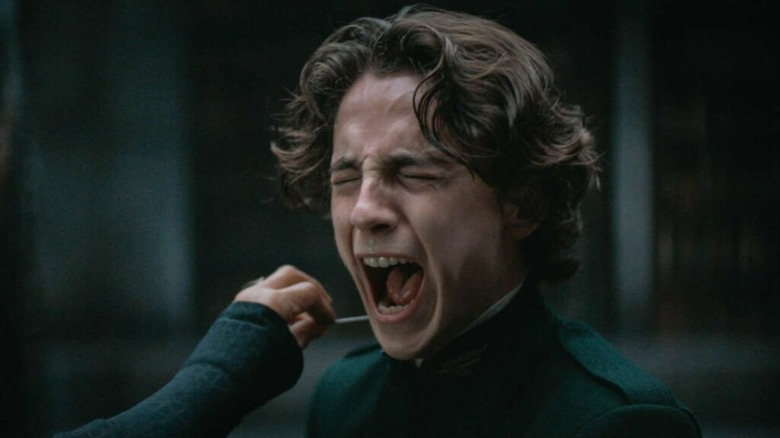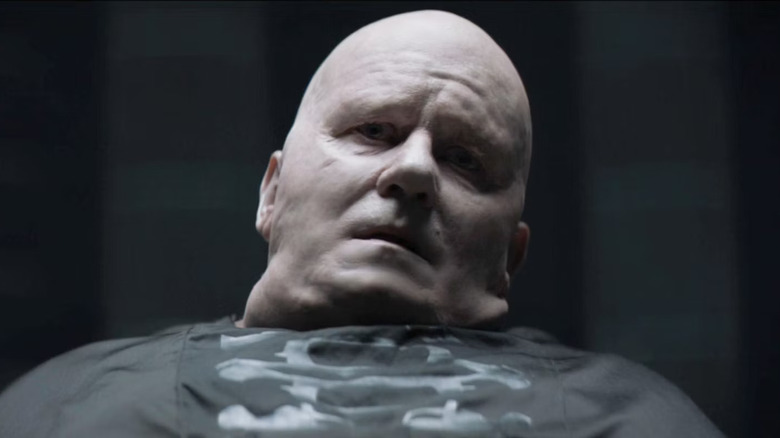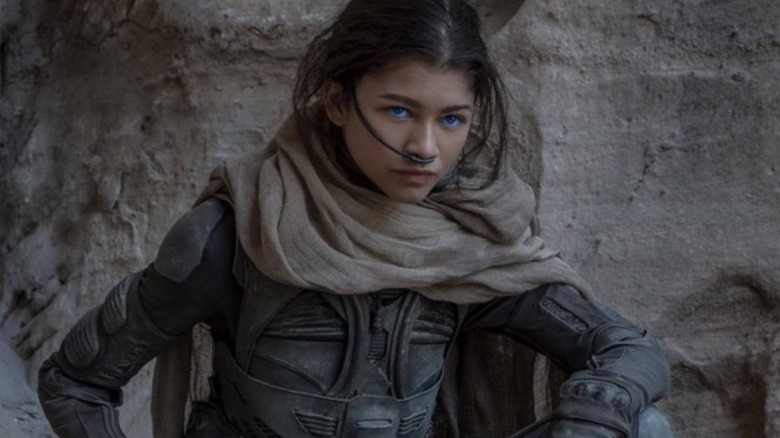The Most Confusing Moments In Denis Villeneuve's Dune Explained
Frank Herbert's classic sci-fi novel "Dune" is a massively complicated story — one that's so dense with lore that it required a glossary of terms and characters when it was first published in 1965. Even attentive readers likely had to spend hours flipping back and forth between the main text of the book and the glossary just so they could understand what a Mentat was or discover the translation of "Muad'Dib."
When Denis Villeneuve adapted the first half of "Dune" to film in 2021, only those of us who had read the original novel, and perhaps also watched David Lynch's 1984 film, could likely follow the story the first time through. There are so many factions and so many characters that it might be difficult to keep them all straight. Once one gets their mind around the various factions within the "Dune" mythos, though, the characters and story begin to fall into place. Thankfully, Villeneuve cast recognizable actors throughout "Dune," allowing viewers to remember them well. Even if one can't recall exactly who Gurney Halleck is, one might recall "the guy played by Josh Brolin." Or, for those who are more fond of Lynch's version, Patrick Stewart.
To wrap your mind around the massive "Dune" mythology, here is a quick primer to remind you of where we stand. Use this guide as preparation for the release of "Dune: Part Two," due in theaters on March 1, 2024. As of now, one needn't concern themselves with the sprawling "Dune" narrative that extends into Herbert's six sequel novels that were written from 1969 through 1985. One also needn't necessarily know all about the nine prequel novels written by Brian Herbert and Kevin J. Anderson (with three more on the way).
No, even without all that, it's complicated enough. Let us prepare.
The spice melange and that big fleshy guy in the Spacing Guild
There are five tribes in "Dune" one needs to know: House Atreides, House Harkonnen, House Corrino, the Fremen, and the Bene Gesserit. It is the year AD 10,191, and humans have mastered space travel and colonized other planets in the galaxy. Most of our story takes place on the planet Arrakis, a hotly contested desert world that modern citizens have nicknamed Dune. Arrakis is hotly contested because it is the only known location of a spice called melange.
The spice is a handy resource. It's essentially a drug that, when consumed, expands consciousness and can grant the user mild psychic powers. It's also required for space travel, as only someone with a spice-expanded mind can accurately pilot much-faster-than-light spacecraft through vast distances in the cosmos. Overconsumption of the spice causes its users to mutate, and the navigators from the Spacing Guild — the organization in charge of space travel — tend to be large, fleshy creatures. A member of the guild appeared in an outsize glass tank in Lynch's "Dune," but they haven't yet been seen in Villeneueve's version.
Naturally, whoever controls the flow of spice is going to have a great deal of power. One can easily see a metaphor between the spice-rich deserts of Arrakis and the real-world oil-rich deserts of the Middle East.
The story begins when House Atreides — led by Duke Leto — is ordered by Padishah Emperor Shaddam IV (of House Corrino) to take over control of Arrakis. Leto moves from his comfortable, watery planet of Caladan, taking his partner Jessica and his son Paul. Paul Atreides is the protagonist of the story. In Villeneuve's film, he's played by Timothée Chalamet.
House Atreides, the Bene Gesserit, and Mentats
Before we get to Paul, let's spend a moment on the Lady Jessica (played by Rebecca Ferguson in Villeneuve's film). She is not only the Duchess of House Atreides but once trained with the Bene Gesserit, an exclusive order of "magical" nuns often employed by noble houses to hone the psychic powers of their progeny. One of their tests is for a charge to insert their hand into a box, while a Bene Gesserit Reverend Mother places a poison needle at their neck. The poison on the needle is called the Gom Jabbar, and if their charge removes their hand from the box, they will be stuck with the needle and die. Paul undergoes a Gom Jabbar test early in "Dune" and finds that the box is a torture device that burns his hand.
The pain, it's later revealed, is psychic pain and Paul's hand is not damaged. But that's why he underwent that bizarro test; his mental acuity was being gauged by the Bene Gesserit. It should be noted that many find the Bene Gesserit to be suspect, given how secretive they are. They could possibly be manipulating the galaxy for their own means. Jessica's training is constantly being passed to Paul.
Paul is also being trained in hand-to-hand combat by his personal trainer, Gurney Halleck, the Atreides army guy.
In the employ of both House Atreides and House Harkonnen are Mentats. Mentats are essentially human computers that have been trained to solve logical problems and do advanced calculations. In Lynch's film, the Atreides Mentat Thifir Hawat was played by Freddie Jones. In Villeneueve's film, he was played by Stephen McKinley Henderson. He was the guy whose eye went white when Duke Leto asked him a logic question.
House Harkonnen, betrayal, and stillsuits
House Harkonnen also has a Mentat named Piter De Vries, played by Brad Dourif in Lynch's film and David Dastmalchian in Villeneuve's.
There is some confusion as to how one should pronounce "Harkonnen," as in Lynch's film the stress is on the second syllable — /har-CONE-an/ — while in Villeneuve's the stress is on the first: /HAR-kih-nan/. (I prefer the first.) The Harkonnens are villains through and through. Prior to House Atreides taking over Arrakis, the Harkonnens ruled the planet and became evil hedonists. The Baron Vladimir Harkonnen has always been depicted, like in the book, as being so massively fat that he requires anti-gravity units (aka suspensors) strapped to his body to move around. In Lynch's film, Vladimir is covered with pustules and loves to torture young men before having sex with them and killing them. In Villenueve's film, he merely bathes in an oil-like mud bath.
The plot of "Dune" is hard to follow, but know that the Harkonnens have been plotting with the Emperor to take back Arrakis from House Atreides as soon as the latter is settled into their new castle. The Emperor, you see, fears the popularity of Duke Leto and wants House Atreides assassinated. The Emperor lends House Harkonnen his secret soldiers — the Sardaukar — to aid in their frontal assault. The Harkonnens are successful, killing the Duke and taking back the planet. Paul and Jessica manage to escape into the desert. That's where Villeneuve's first movie ends.
Paul and Jessica are able to survive in the desert for two reasons. For one, they have access to stillsuits, a special survival outfit that retains every milliliter of their bodily fluids and keeps them cool. (Yes, the stillsuits recycle one's urine and feces into drinkable water.) Secondly, the Fremen live there.
The Fremen, the Shai Hulud, and the Kwisatz Haderach
The Fremen are the natives of Arrakis, and they live in remote areas of the desert. No one from House Harkonnen has been able to find and apprehend them because of the enormous sandworms that live in the desert. The sandworms, or Shai Hulud, are hundreds of feet long, live underground, and will come to the surface if they ever hear anything repeatedly beating on the ground ... like footsteps. They're a lot like the Graboids from "Tremors." The Fremen must step arhythmically to avoid being detected by sandworms, which is why Paul and Jessica walk so funny in the desert.
The Fremen characters are easy to spot, as their eyes have turned blue from constant exposure to the spice. The Fremen attache to House Atreides is a character named Stilgar (Max Von Sydow in Lynch's version, Javier Bardem in Villenueve's) and he serves to deliver a lot of exposition about stillsuits and sandworms. The Fremen are dismissed by the royal families who occupy Arrakis, but are actually legion, representing huge armies out in the desert. They have their own language and culture. Paul ends up falling in love with Chani (Sean Young in Lynch's film, Zendaya in Villeneuve's), a young Fremen woman.
The Fremen respect combat and have to test Paul before he and Jessica can be welcomed into their ranks. This is why Paul fought with a Fremen man in the climax of Villeneuve's film.
The Fremen, because they are infused with spice, practice a robust, prophecy-related religion that tells of the coming of a Messiah, likely the same Messiah foretold by the Bene Gesserit, called the Kwisatz Haderach. No points for guessing that Paul will fill that prophecy. Paul's Fremen name "Muad'Dib" — which is inspired by both a crater on the moon and a desert-dwelling jerboa — appears in Villenueve's "Dune: Part Two."
